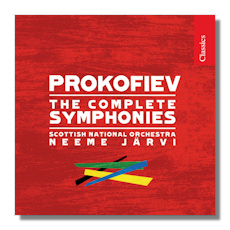
The Internet's Premier Classical Music Source
Related Links
- Prokofieff Reviews
- Latest Reviews
- More Reviews
-
By Composer
-
Collections
DVD & Blu-ray
Books
Concert Reviews
Articles/Interviews
Software
Audio
Search Amazon
Recommended Links
Site News
 CD Review
CD Review
Serge Prokofieff

Complete Symphonies
- Symphony #1 in D Major "Classical", Op. 25
- Symphony #2 in D minor, Op. 40
- Symphony #3 in C minor, Op. 44
- Symphony #4 in C Major, Op. 112 (1947 version)
- Symphony #4 in C Major, Op. 47 (1930 version)
- Symphony #6 in E Flat minor, Op. 111
- Symphony #5 in B Flat Major, Op. 100
- Symphony #7 in C minor, Op. 131
Royal Scottish National Orchestra/Neeme Järvi
Chandos CHAN10500 4CDs 4:19:46
These symphonies were originally recorded in 1984-85 and featured sound typical of Chandos at the time: the perspective was slightly distant, but with ample detail and powerful fortes. In A-B comparisons I noticed no significant difference between this remastered set of symphonies and the originals. But of course, the price is lower and the buyer gets all the symphonies on four discs, not spread over six with fillers as were original issues.
How do the performances rank? Järvi is sort of a centrist in Prokofieff: tempos tend to be moderate to slightly brisk, and textures are fairly juicy, rarely lean. When Järvi can play up the epic and dramatic, he seldom passes up the chance: try the Fifth and Sixth in their big moments (the Fifth's first movement ending; the Sixth's first movement development section). When he is given the opportunity to highlight the ironic or the sarcastic, it's not that he plays those elements down, but he is a bit less effective: try the Fifth's Scherzo or the revised Fourth's finale.
His Classical Symphony generally captures the wit and elegance of the work, but for those wanting a fleeter, more 18th-century spirit, they'll have to look to Levi or Bernstein or Gergiev. Järvi's Second is solid throughout, clarifying what is a difficult symphony for some listeners. His Third is atmospheric and powerful, certainly one of the finer accounts available. His early Fourth may be the best reading here: it's fleet and potent, capturing its balletic spirit and thematic richness. The later Fourth is also good: like the Fifth, it is epic and full of drama. But Järvi's Fifth is also dark and features greater depth, not surprising traits in a work that is one of the more powerful symphonies of the 20th century.
An even greater symphony is the Sixth, however, and here it receives an intense and powerful reading, one surpassed, though, by Gergiev and the recent, ear-opening Kitayenko. The Seventh fares well in Järvi's hands, though I think the work needs slightly more relaxed pacing. The playing is fine throughout the set, though the string section sounds a bit underpowered. In sum, this is a fine Prokofieff symphony cycle, but in the budget realm Naxos has a set led by Theodore Kuchar that is also worthy of consideration. If price is not a consideration, I would opt first for the Kitayenko on Phoenix Edition, and next for the Gergiev on Decca/London. Still, Järvi must be ranked among the top three or four conductors in the Prokofieff symphony sweepstakes.
Copyright © 2008, Robert Cummings





















